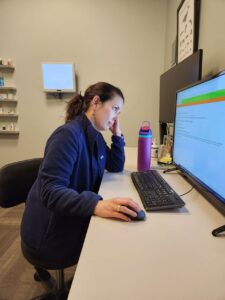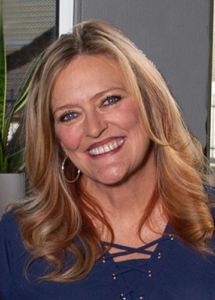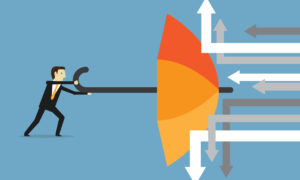
Susan Shauger, OD, from Dr. Sorrenson’s practice, Lakeline Vision Source, reviewing charts. Dr. Sorrenson says that charting after hours is not the norm. It’s a sign that you may need to make a change in how you do this task.
Figuring out what causes after-hours charting & finding solutions.
By Laurie Sorrenson, OD, FAAO
Feb. 21, 2024
I received many e-mails in response to my column on chartaholics. After engaging in conversations with some of these individuals, and consulting with doctors known for their efficiency—who never find themselves working late on charts—I decided to delve deeper into this challenge.
Getting to Root of the Problem
As I thought about the challenges of staying late to complete charts, it occurred to me that perhaps we need to go back to the basics to address the root of the problem.
One possible starting point is examining the mindset behind spending extensive hours on charting.
Could it be that some practitioners aren’t aware that the majority of doctors don’t follow this norm? I’m here to clarify that it’s not the standard way to spend your optometry career. Routinely or extensively staying after hours to finish charting happens, but is not the norm.
Another factor to consider is fear. Are some optometrists anxious about audits, whether from medical plans or vision plans? Medical plan audits are less common for optometrists, but it seems like optometrists spend significant time worrying about being audited. Not that you should not do your due diligence, but spending hundreds of hours charting after hours every year doesn’t make sense.
Vision plans conduct audits much more regularly now, but they are primarily focused on potential over-billing. I spoke with Joe DeLoach, OD, FAAO, from Practice Compliance Solutions, who provides a service auditing charts for doctors, and surprisingly, most of the recommendations PCS provides aren’t solely about increasing charting, but often relate to doctors over-charting!! Hiring their service, or any other chart-auditing service to conduct a chart audit, and expressing an intention to streamline your charting process, could be a viable option.
A Habit You Formed While Still in School?
Could the persistent mindset of exhaustive charting be a carryover from school? In academic settings, thorough charting is often rewarded, but the reality in clinical practice is different.
It may also be time to reevaluate the necessity of every test and procedure conducted during exams. In school, most attendings require you do every test under the sun while doing 1-2 hour eye exams. That doesn’t work in a typical optometric practice. Consider having a colleague come watch you do an eye exam and vice versa, exchange ideas and explore ways to streamline the eye exam.
Are you doing things that aren’t necessary? What else can you do to streamline your exams, so you have more time to chart during the exam? Do you have your EHR set up to use defaults, text expanders and drop-down boxes?
Other Articles to Explore
Delegating Can Reduce Chartaholic Tendencies
Delegating tasks is a crucial aspect of practice leadership that many meticulous (so-called “perfect” personality type) doctors struggle with. Consider having a meeting with staff and technicians about potential responsibilities they can handle to free up more time in the exam room. I bet they would love for you to ask for their assistance, and do more to help you and the patient!
Many doctors use a scribe, which I highly recommend. Whether it’s having a scribe with you in-person or virtually, this can be a game-changer for efficiency, thoroughness, and for me, it makes seeing patients more fun!
Interestingly, I recently heard of a doctor who employs a scribe, but ends up rewriting all the notes the scribe inputs, spending additional time after hours without informing the scribe about the changes made. This approach, which involves spending money on a service and then investing more time to redo the work, doesn’t make sense. Make sure you give your scribe feedback, and let them redo the chart for you if it needs to be redone!
A Multifaceted Approach is Needed to Stop Being a Chartaholic
In essence, tackling the issue of late charting involves a multifaceted approach—changing your mindset, reassessing your examination procedures and effectively delegating.
I hope this column can help you break free of the chartaholic cycle. Optometry is sooo much fun, but staying late, working on the weekends, etc., ain’t much fun at all!!!!
 Laurie Sorrenson, OD, FAAO, is president of Lakeline Vision Source in Cedar Park, Texas, and the Professional Editor of Review of Optometric Business (ROB). To contact her: lsorrenson@gmail.com.
Laurie Sorrenson, OD, FAAO, is president of Lakeline Vision Source in Cedar Park, Texas, and the Professional Editor of Review of Optometric Business (ROB). To contact her: lsorrenson@gmail.com.



























